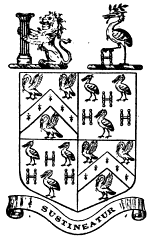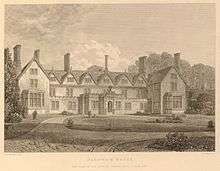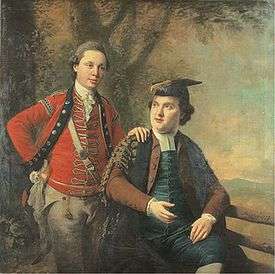Thomas Gery Cullum
Sir Thomas Gery Cullum, 7th Baronet FSA (30 November 1741 – 8 September 1831) was a medical doctor educated at London Charterhouse and Trinity College, Cambridge,[1] and who later practised surgery at Bury St. Edmunds, Suffolk, where he served as an alderman and DL for Suffolk. Cullum was the son of Sir John Cullum, 5th Baronet, of Hardwick House, Hardwick, Suffolk.[2]
%2C_6th_Baronet.jpeg)

Career
Sir John Cullum, 6th Baronet (1733–1785), the brother of Thomas Gery Cullum, was known as the 'historian of Hawstead'.[3] His brother and successor Thomas shared his literary inclinations, and became 7th Baronet in 1785. He was a well-regarded writer on science and on botany and a fellow of the Royal Society, Society of Antiquaries of London and of the Linnaean Society.[4]

Cullum's credentials as a scholar were such that he was recommended as a fellow of the Royal Society in January 1787 along with his fellow scholar James Smithson, for whom the later Smithsonian Institution would be named.[5] Cullum also served as Bath King of Arms from 1771 to 1800.[6] He was succeeded as Bath King of Arms by his son John Palmer Cullum, Esq, who served from 1800–1829, which meant that between them the pair served for nearly 60 years.[7]
Perhaps the highest compliment paid to Cullum was that from Sir James Edward Smith, noted English botanist and founder of the Linnaean Society. Smith dedicated his English Flora of 1824 to Cullum thus: "To Sir Thomas Gery Cullum, Bart., whose knowledge and love of natural science entitle him to the respect of all who follow the same pursuit, this work is inscribed in grateful and affectionate remembrance by the Author."[8] Smith's publications had followed a privately printed flora by Cullum, Floræ Anglicæ Specimen imperfectum et ineditum, 1774, which was based on the Linnean system of classification[9]
Sir Thomas Gery Cullum was married to Mary Hanson[10] of Normanton, West Yorkshire, daughter of Robert Hanson Esq.[11] and heiress of her brother 'Sir' Levett Hanson,[12] chamberlain to the Duke of Modena and an authority on European orders of knighthood. Hanson acted as surety for the baptism of his sister's first son John Cullum.[13] (On his death in Copenhagen without an heir, Hanson left his estate, including portraits and mementoes of the Levett and Gargrave families of Yorkshire, to his sister.)[14]

Cullum lived at Hardwick House, a Jacobean house on the site of medieval grazing land for St. Edmundsbury Abbey, which the Cullum family owned from its initial purchase in 1656, by the Royalist Sir Thomas Cullum, 1st Baronet and former Sheriff of London, until 1921.[15] Natives of Suffolk, the 1st baronet had grown rich as a London draper, then fallen out of favour on Cromwell's rise, but returned to favour on the Restoration, when he was rewarded with a Baronetcy.[16]
The house, which included a Venetian indoor riding school and extensive grounds,[17] was demolished in 1921 when the last of the Cullums, George Gery Milner-Gibson Cullum, grandson of the 8th Baronet and High Sheriff of Suffolk, died without heirs.[18]
The grounds and site of the formal gardens and statuary today constitute Hardwick Heath (55 acres (22 ha) of the former Cullum estate turned into public parkland), the West Suffolk Hospital, the grounds of Hardwick Manor and housing developments. The site of Hardwick House itself is a wood bordering some original Cedar and Yew trees.[19]
During the time of their residence at Hardwick House, the Cullum family had maintained an extensive library,[20] and had also taken great interest in the history of the area, including having authored several volumes on the history and antiquities of Hawsted and Hardwick.[21] Following the sale of the Hardwick Estate, most of the Cullum library, the Cullum Collection, was given to the Bury Record Office.[22] An oil portrait descended in the Levett family of Sir Thomas Gargrave, Speaker of the House of Commons, was donated to the National Portrait Gallery in London by the last Cullum baronet.[23]
Sir Thomas Gery Cullum, surgeon, botanist, antiquarian, and writer is buried in the church at Hawstead, Suffolk with many of his ancestors and descendants. Few churches in Suffolk have as many monuments to their dead, say scholars, as the church in Hawstead.[24]
A genus of flowering plant, Cullumia, commemorates the contribution of Cullum and his brother.[9]
See also
- List of Old Carthusians
- Hardwick House (Suffolk)
- Lady Drury's Closet
References
- "Cullum, Sir Thomas Gery, Bart. (CLN786TG)". A Cambridge Alumni Database. University of Cambridge.
- The Baronetage of England, John Debrett, Seventh Edition, William Courthope (ed.), J. G. & F. Rivington, London, 1839]
- "The Gentleman's Magazine, Vol. IX, January to June 1838, Sylvanus Urban, William Pickering, John Bowyer & Sons, 1838".
- "The Gentleman's Magazine, Vol. XLIII, Sylvanus Urban, John Bowyer Nichols and Sons, London, 1855".
- "James Smithson and His Bequest, William Jones Rhees, Smithsonian Institution, Published by the Smithsonian Institution, Washington, D.C., 1880".
- "The Annual Register, Or, A View of the History, Politics, and Literature for the Year 1772, J. Dodsley, T. Davison, London, 1809".
- "A Supplement to The Suffolk Traveller (of J. Kirby), or Topographical and Genealogical Collections, Concerning that County, Augustine Page, John Kirby, Joshua Page, Ipswich, 1844".
- "The Gentleman's Magazine, July to December, 1831, Vol. CI, Sylvanus Urban, J. B. Nichols and Son, London, 1831".
- Boulger, George Simonds (1888). . In Stephen, Leslie (ed.). Dictionary of National Biography. 13. London: Smith, Elder & Co.
- "Miscellanea Genealogica et Heraldica, Joseph Jackson Howard (ed.), Vol. I, Third Series, Mitchell and Hughes, London, 1896".
- "The Gentleman's Magazine, January, 1855, F. Jeffries, London".
- "Miscellanea Genealogica et Heraldica, Joseph J. Howard, reissued by Adamant Media Corp., 2001".
- "The Gentleman's Magazine, From July to December 1831, Vol. CI, Sylvanus Urban, J. B. Nichols and Sons, London, 1831".
- . Dictionary of National Biography. London: Smith, Elder & Co. 1885–1900.
- Approach to Hardwick House, early 20th-century, Bury St Edmunds Past and Present Society, burypastandpresent.org
- "The Endowed Charities of the City of London, M. Sherwood, London, 1829".
- Photos of Hardwick House and Estate, Bury St Edmunds Past and Present Society, burypastandpresent.org Archived 20 August 2008 at the Wayback Machine
- "Print (coloured) of Grant of Arms to Dame Mary Cullum, only daughter of Robert Hanson of Normanton, Co. York; Copied from the original in the possession of Gery Milner-Gibson-Cullum, Esq., F.S.A. 1783, Cullum Collection, 1584–1918, Suffolk County Record Office, Bury St Edmunds Branch, The National Archives, nationalarchives.gov.uk".
- "Hardwick Heath, St. Edmundsbury Borough Council, West Suffolk, stedmundsbury.gov.uk".
- One of the libraries at Hardwick House, Bury St Edmunds Past and Present Society, burypastandpresent.org
- A Bibliographical Account of the Principal Works Relating to English Topography, Vol. III, William Upcott, Richard and Arthur Taylor, London, 1818
- The Bury St Edmunds branch of the Suffolk Record Office has, as part of the Cullum bequest, a 'pedigree of Levett of Normanton and Melton, and Hanson of Normanton, Yorkshire,' as well as a 'coloured print of Levett and Hanson Arms.'
- "Miscellanea Genealogica et Heraldica, Joseph Jackson Howard (ed.), Vol. I, Third Series, Mitchell and Hughes, London, 1896".
- "The Buildings of England: Suffolk, Nikolaus Pevsner, Enid Radcliffe, Yale University Press, 2004".
- IPNI. Cullum.
External links
- . Dictionary of National Biography. London: Smith, Elder & Co. 1885–1900.
- Sir Thomas Gery Cullum, A General and Heraldic Dictionary of the Peerage and Baronetage of the British Empire, John Burke, 1832
| Heraldic offices | ||
|---|---|---|
| Preceded by Samuel Horsey |
King of Arms of the Order of the Bath 1771–1800 |
Succeeded by John Palmer Cullum |